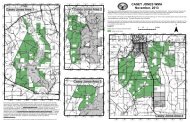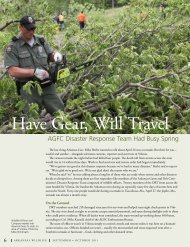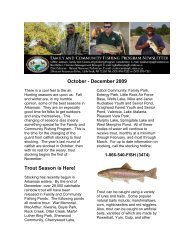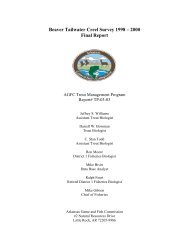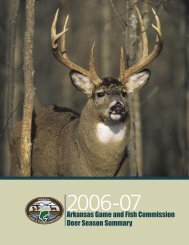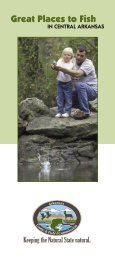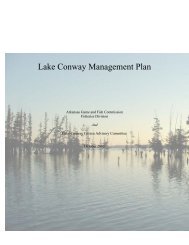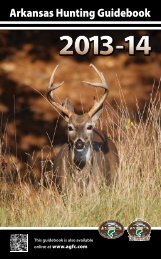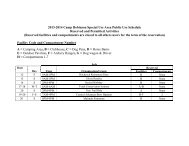130824_GBK 2013-14 Waterfowl Guidebook.indd - Arkansas Game ...
130824_GBK 2013-14 Waterfowl Guidebook.indd - Arkansas Game ...
130824_GBK 2013-14 Waterfowl Guidebook.indd - Arkansas Game ...
Create successful ePaper yourself
Turn your PDF publications into a flip-book with our unique Google optimized e-Paper software.
Ducks of <strong>Arkansas</strong>Ducks of <strong>Arkansas</strong>MallarddrakeLook fora greenhead and asharp contrastbetween the chestnutbreast and gray belly.M a l l a rdLength – 24 inchesMore than 50 percent ofducks taken in <strong>Arkansas</strong> aremallards. More mallards areshot in <strong>Arkansas</strong> than in anyother state.Mallard henBl a c k D uc kLength – 24 inchesLooks like a dark version of amallard hen. White underwingsand pale head contrast witha dark body. Often fl ies withmallards. Hens and drakeshave a similar appearance.Fewer than 2,000 are taken in<strong>Arkansas</strong> each year.Mot t le d D uc kMottled ducks are rare in <strong>Arkansas</strong>, but areoccasionally taken on their way to winter alongthe Gulf of Mexico. Drake and hen mottled duckslook like hen mallards, but the body feathers area little darker than the mallard, yet not as dark asa black duck, and have the characteristic mottlingshown in this photograph. The wing patch hasa blue-green tint, no front white bar and a rearfaded white stripe may be present.Steven Holt/stockpix.com16 <strong>Arkansas</strong> <strong>Game</strong> and Fish Commission <strong>Waterfowl</strong> Hunting <strong>Guidebook</strong> <strong>2013</strong>-<strong>14</strong>
Ducks of <strong>Arkansas</strong>American WigeonLength – 21 inchesLook for a showy white belly anda light blue bill tipped with black.Generally seen in small flocks andtaken in low numbers.Wigeon henWigeon drakeLook for whitepatches on theshoulder, whiteforehead and agreen eye band.Northern ShovelerLength – 21 inchesHas an undeservedreputation for beingpoor table fare.Shoveler drakeLook for a wide, spoonlikebill, a white breast, adark belly and pale blueshoulder patches.Shoveler henLook for an orange, spoon-likebill. Otherwise, looks like asmall mallard hen.Goldeneye drakeRarely seen in <strong>Arkansas</strong>.Fewer than 1,500 shoteach year in <strong>Arkansas</strong>.C om mon G olde ne yeLength – 19 inchesDistinctive wing-whistling soundin fl ight has earned the name of“whistlers.” These are active, strongwingedfl iers moving singly or in smallflocks. Generally seen on large riversand lakes. Look for chunky body, fastdirect fl ight, flash of white on wing.18 <strong>Arkansas</strong> <strong>Game</strong> andFish Commission <strong>Waterfowl</strong> Hunting <strong>Guidebook</strong> <strong>2013</strong>-<strong>14</strong>
Blue-winged TealLength – 16 inchesLook for rapid, twisting fl ightin dense flocks. Shoulders arepale blue. Less than onethirdthe size of a mallard.Most have migrated through<strong>Arkansas</strong> to Mexico andCentral America by mid-October.Blue-wingedteal drakeDucks of <strong>Arkansas</strong>Bluewingedteal henGreen-wingedteal henGreen-wingedteal drakeAmericanGreen-winged TealLength – 15 inchesThe smallest duck seen in<strong>Arkansas</strong>. A fast duck thatfl ies in dense flocks similarto those of blue-wingedteal. Both sexes appear paleunderneath and dark on top.Two pale lines on the top ofwings are often visible. Tealprefer shallow water and arecommon in rice fields.CanvasbackdrakeLook for a redhead, a palecoloredbodywith a darkbreast.C a nva sba c kLength – 22 inches<strong>Arkansas</strong>’s largest and fastest duck. Look for asloped forehead and a dark bill. Wingbeats arenoisy and rapid.CanvasbackhenThe samedistinctiveprofi le as thedrake.<strong>Arkansas</strong> <strong>Game</strong> and Fish Commission <strong>Waterfowl</strong> Hunting <strong>Guidebook</strong> <strong>2013</strong>-<strong>14</strong>19
Ducks of <strong>Arkansas</strong>R e d he a dLength – 20 inchesLooks similar to a canvasbackexcept its forehead is morerounded. Its bill is blue with awhite and black tip. Occasionallyseen on reservoirs and deep waters.RedheaddrakeRedheadhenRuddy DuckLength – 15½ inchesWhen flying, their smallwings stroke so fast theyresemble bumblebees.Hens and drakes aresimilar in appearance duringfall. Look for white cheekpatch on males. Often seenon minnow ponds and largelakes with buffleheads.Ruddy duck henRuddyduck drakeBufflehead henBuffleheaddrakeBold black-andwhitepattern.Bu ffleheadLength – <strong>14</strong>½ inchesSmall, fast-flying duck. Look for white on its headand wings. Plump appearance. Often seen withruddy ducks.20 <strong>Arkansas</strong> <strong>Game</strong> and Fish Commission <strong>Waterfowl</strong> Hunting <strong>Guidebook</strong> <strong>2013</strong>-<strong>14</strong>
Ducks of <strong>Arkansas</strong>Ring-neckeddrakeRingneckeddrakeeclipseRing-necked DuckLength – 17 inchesSwift, erratic fl ight. Look for adark head and breast with a whitebelly. Dark back and wings helpdistinguish this duck in fl ightfrom scaup. Often seen in ricefields and agricultural reservoirs.RingneckedhenScaup drakeCommonly seen onthe <strong>Arkansas</strong> Riverlate in the season.S c a upLength – 18½ inchesLooks similar to a ring-necked duckbut with a white back, bright bluebill and white on its wings.<strong>Arkansas</strong> <strong>Game</strong> and Fish Commission <strong>Waterfowl</strong> Hunting <strong>Guidebook</strong> <strong>2013</strong>-<strong>14</strong>Scaup henLook for a distinctwhite face patch.21
Ducks of <strong>Arkansas</strong>Hooded MerganserLength – 21½ inchesMergansers have narrow, pointed bills. A hoodedmerganser is small with a “hood,” and has black andwhite on each wing patch feather.HoodedmerganserdrakeHoodedmerganserhenRed-breasted MerganserLength – 23 inchesUncommon. Flight is strong and direct, usually lowover the water. Difficult to distinguish in fl ightfrom the common merganser. Female’s head andneck are paler than female common merganser.Red-breastedmerganser drakeRed-breastedmerganser henCommonmerganser henC om mon Me r g a n s e rLength – 25½ inchesFlocks move in “follow the leader”style, low over the water. Look forgreen head and white body on thedrake. Female’s bright chestnut,crested head contrasts sharply withwhite chin and breast.Commonmerganser drake22 <strong>Arkansas</strong> <strong>Game</strong> and Fish Commission <strong>Waterfowl</strong> Hunting <strong>Guidebook</strong> <strong>2013</strong>-<strong>14</strong>
Drive with pride.Now available at a revenue office near you.Visit an <strong>Arkansas</strong> Revenue Office or call 1-800-364-GAMEto purchase a gift certificate now. Of your $35 purchase, $25benefits the scholarship program and other educational effortsof the <strong>Arkansas</strong> <strong>Game</strong> and and Fish Fish Commission. <strong>Waterfowl</strong> Hunting <strong>Guidebook</strong> <strong>2013</strong>-<strong>14</strong>www.agfc.com23
Geese of <strong>Arkansas</strong>Geese of <strong>Arkansas</strong>C a n a d a G oo s eBlack head and neck is marked with distinctive white “chin strap” stretching from earto ear. Like other geese, sexes look alike. Giant Canada geese weigh 9-15 pounds andlive in <strong>Arkansas</strong> year-round. Interior Canadageese weigh 7-9 pounds and nest on the coastof Hudson Bay in Ontario, Canada. Cacklinggeese weigh 4-5 pounds and nest even farthernorth in the Northwest Territories of Canada.InteriorGiantCacklingadultjuvenileWhite-fronted Goose (specklebelly)Both the adult and juvenile are grayish brown with tails edged with white. Adults havea distinct white face patch and barring on the belly that gives the bird its name. Theyellowish legs and bill of the juvenile distinguish it from the juvenile blue goose.24 <strong>Arkansas</strong> <strong>Game</strong> and Fish Commission <strong>Waterfowl</strong> Hunting <strong>Guidebook</strong> <strong>2013</strong>-<strong>14</strong>
Geese of <strong>Arkansas</strong>Illustrations by Bob Hines from “Ducks, Geese and Swans of North America”by Frank C. Bellrose. Courtesy of the Wildlife Management Institute.Snow Goose (white color phase)The adult’s body is white with black wing tips,a pink bill with a dark grin patch and pinkishredlegs. In early fall, the juvenile is dingy whitewith black wing tips. The dingy feathers arereplaced last on the top of the head. The legsand bill of the juvenile are grayish brown.adultjuvenileadultBlue Goose (blue color phaseof Snow Goose)The adult has a slate gray body with awhite head, black wing tips, variableamounts of white on its belly, a pink billand red legs. The juvenile has a sootyblue-gray body with a white chin spotand grayish brown legs and bill.juvenilejuvenileadult<strong>Arkansas</strong> <strong>Game</strong> and Fish Commission <strong>Waterfowl</strong> Hunting <strong>Guidebook</strong> <strong>2013</strong>-<strong>14</strong>Ross’s GooseThis goose looks like asmall snow goose. Lookfor a smaller body size, ashorter bill and bumps atthe base of the bill. TheRoss’ goose lacks the dark“grin patch” of the snowgoose bill.25



